|
Nature Trail
Birds of paradise:
Simply magnificent
A unique species of animal that has always fascinated mankind with
their ability to conquer the skies by flapping their wings, are the
birds. With their diverse lifestyles, skills, colourful plumage, talons
and beaks, our feathered friends have captured our interest and fired
our imagination not merely to write poems, paint
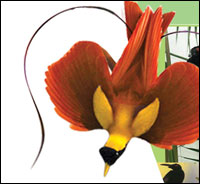 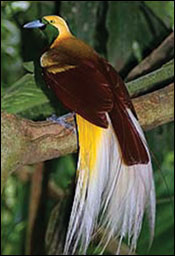 pictures
or do documentaries on them, but also to invent machines that could fly,
like them. pictures
or do documentaries on them, but also to invent machines that could fly,
like them.
On a 1-10 scale, it's hard to decide as to which bird should be
placed at what level of the scale since there are so many who are indeed
awesome; the peacocks with their strikingly beautiful fan-like
iridescent (colour changing) tails, the macaws with vibrantly hued
feathers, the birds of prey, such as the falcon and eagle that spot
their prey from miles away, even in water, and catch them with their
powerful talons (claws), the Emperor Penguins that brave the harshest
weather in the Antarctica or the toucans with their striking colourful
beaks that are almost half the size of their bodies - the list is indeed
endless. From the smallest of the birds, the bee hummingbird, to the
largest, the ostrich, our feathered friends in the avian world have
something to boast about. Even though the ostrich may not be able to fly
or have a magnificent plumage like many of its avian family members, it
can certainly be proud of being the record holder for the largest egg.
From among all these fascinating avian friends, we like to introduce
you to a species of bird whose name speaks for its magnificence. They
are none other than the birds of paradise. Why paradise? It is said that
this particular species of bird came to be first known from specimens
brought back by explorers from traders during their trading expeditions
in the land the birds were found in. The native traders had apparently
made decorations out of the dead birds by removing their wings and feet.
The ancient explorers, who had not been aware of this fact, had believed
that the birds never landed, but were kept aloft (on high) by their
plumes. This led to the origin of both the name 'birds of paradise' and
also the specific scientific name apoda which means without feet. Apart
from this factor, it is also said that the spectacular appearance of
these birds, especially the males, contributed to the bird's being so
named.
The dazzling feathers of the male birds of paradise earned them their
name because many natives were of the view that these birds could only
have come from
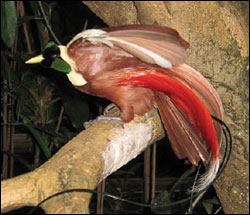 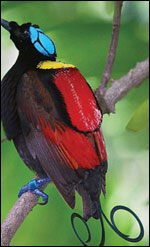 paradise
with such stunning coloured plumes. In fact, these birds are best known
today because of their plumage. Males of most species have highly
elongated (lengthened) and elaborate feathers, extending from either the
beak, wings or the head. These birds are distinguished as the world's
most dramatic and attractive birds by their strikingly coloured plumage
of yellow, blue, scarlet and green. Males often sport vibrantly coloured
feathered ruffs or amazingly elongated feathers which are referred to as
streamers or wires by naturalists. Some species of male birds even have
enormous head plumes or other distinctive ornaments such as head fans or
breast shields. paradise
with such stunning coloured plumes. In fact, these birds are best known
today because of their plumage. Males of most species have highly
elongated (lengthened) and elaborate feathers, extending from either the
beak, wings or the head. These birds are distinguished as the world's
most dramatic and attractive birds by their strikingly coloured plumage
of yellow, blue, scarlet and green. Males often sport vibrantly coloured
feathered ruffs or amazingly elongated feathers which are referred to as
streamers or wires by naturalists. Some species of male birds even have
enormous head plumes or other distinctive ornaments such as head fans or
breast shields.
What is most spectacular is the ritualistic dance the males put on to
attract a mate. Putting to good use their vibrantly coloured feathers
and unusual ornaments, the males do elaborate dances for hours. These
dances which are phenomenal (remarkable), vary from one species to
another.
The magnificent bird of paradise which is rarely seen is said to be
different to most other ordinary birds, in that, it has two loose
elongated spiral wire-like elements extending beyond the rest of the
tail feathers. The male birds which are only 19-26 cm have darkish green
breasts and wings that are covered with shiny orange feathers. The
feathers on the upper neck are shaped into a cape-like fan and are
striped yellow. The females are about 19 cm in length and have an olive,
light brown-black striped breast from her lower neck to her lower tail.
The tail is not like that of the male's, and is very ordinary. Both male
and female birds have bluish coloured beaks and feet and jet black eyes.
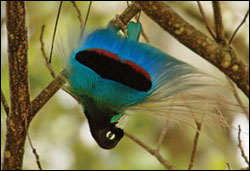 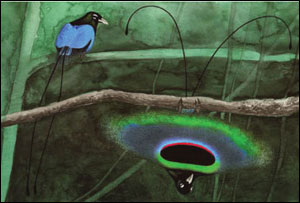 The
male bird seems obsessed in cleaning the area it uses to display its
ritualistic dance to attract a mate. It uses five different types of
calls to attract the attention of female birds in the vicinity. And once
a female enters the arena, it starts to display its dancing ritual which
includes five different performances such as the breast display,
horizontal display (or cape display), dancing display and back display.
When performing the breast display, it inflates and deflates his
breast-shield. This makes it look like an over muscular body builder
with chest muscles projected on both sides of its ears. In the second
display, the bird generally clings on to a vertical stem which is about
a foot off the ground and shows off its cape. In the next stage it
lowers the cape backwards whilst still clinging to a vertical stem,
shows off his breast plate and also the mouth coloration before going to
the following stage where it displays the bright coloration in the rear
area and also clings to a horizontal tree while dancing. The
male bird seems obsessed in cleaning the area it uses to display its
ritualistic dance to attract a mate. It uses five different types of
calls to attract the attention of female birds in the vicinity. And once
a female enters the arena, it starts to display its dancing ritual which
includes five different performances such as the breast display,
horizontal display (or cape display), dancing display and back display.
When performing the breast display, it inflates and deflates his
breast-shield. This makes it look like an over muscular body builder
with chest muscles projected on both sides of its ears. In the second
display, the bird generally clings on to a vertical stem which is about
a foot off the ground and shows off its cape. In the next stage it
lowers the cape backwards whilst still clinging to a vertical stem,
shows off his breast plate and also the mouth coloration before going to
the following stage where it displays the bright coloration in the rear
area and also clings to a horizontal tree while dancing.
Even the superb bird of paradise, which is a small bird with velvet
black, metallic-like green iridescent plumage on the crown, erectile
iridescent breast shield and a spreadable cape gives a 'superb'
performance.
These spectacular birds which are members of the Paradisaeidae family
and are so popular for their coloured plumage and also dance display,
are crow-like in general appearance. They are the brother group to the
Corvids - the crows and jays. They generally have stout or long bills,
strong feet and range in size; the king bird of paradise at 15 cm and 50
grams to the black sicklebill at 110 cm and the curl-crested manucode at
430 grams.
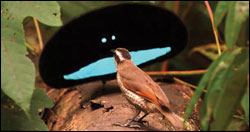 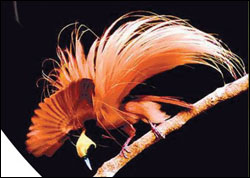 These
birds are found in eastern Indonesia, Torres Strait Islands, Papua New
Guinea and eastern Australia. They live in tropical forests including
rain forest, swamps and moss forest. The diet of most species is
predominantly fruits, but some like the riflebirds and sicklebills also
like insects and other arthropods. These
birds are found in eastern Indonesia, Torres Strait Islands, Papua New
Guinea and eastern Australia. They live in tropical forests including
rain forest, swamps and moss forest. The diet of most species is
predominantly fruits, but some like the riflebirds and sicklebills also
like insects and other arthropods.
Many species of this spectacular birds are listed as near threatened
or threatened. Hunting for their plumes and habitat destruction been the
main reason for those species being reduced to endangered status.
These beautiful birds have lent their name to a colourful flower,
south Africa's bird of paradise (Strelitzia reginae) which is a member
of the banana family. Look out for more details of this plant in the
future issues.
***********
Different species :
There are about 43 species of birds of paradise in different genera
(group). The manucodes are the most primitive of the group and include
the Jobi manucode, Trumpet manucode Curl-crested manucode and the
crinkle-collared manucode. In the Paradigalla genus there is the
long-tailed and short-tailed paradigallas. The superb bird of paradise
belongs to the Lophorina genus while the magnificent riflebird and
Paradise riflebird belong to the Ptiloris genus. The famous Wilson's
bird of paradise and magnificent bird of paradise both are from the
Cincinurus genus. The sicklebills are from the Epimachus. The wired
birds, such as the twelve-wired bird of paradise and the six-wired bird
of paradise belong to the genus of Seleucidis, while the spectacular
Reggiana bird of paradise, Red bird of paradise, Blue bird of paradise,
Emperor bird of paradise and Goldie's bird of paradise all are in the
genus, Paradise.
***********
Fact file:
* Birds of paradise plumes are often used in dresses and rituals by
societies of New Guinea.
* The birds which were hunted extensively for the millinery (women's
head gear) trade are under legal protection today. Hunting is permitted
on a limited level to fulfil ceremonial needs of the local tribal
population.
* It is said that when it was discovered that the bird of paradise
plumes of the Nepali Royal Crown were in need of replacement due to the
ban on hunting, the officials had no choice, but to get some feathers
from a shipment of bird feathers confiscated by the US customs.
* The constellation Apus in the southern hemisphere represents a bird
of paradise.
* The flag of Papua New Guinea depicts an adult-plumaged male bird of
paradise.
* Wilson's bird of paradise which is near threatened has the
controversial Latin name Cicinnurus respublica Bonaparte given by
Napoleon Bonaparte's nephew - Lucien Bonaparte.
* They build their nests from soft materials such as leaves, ferns
and vine tendrils typically placed in a tree fork.
* The clutch size is not known, but the eggs hatch after 16-22 days.
The young leave the nest at between 16 and 30 days of age.
Facts and pix: Internet
*********** |

